My mother is a superhero.
Unmatched in courage, faith, commitment.
I look to her like all mortals look to heroes,
and offer this heartfelt
thank you,
time and again.
For Thressa Mae Brown
Happy birthday, Mom.
My mother is a superhero.
Unmatched in courage, faith, commitment.
I look to her like all mortals look to heroes,
and offer this heartfelt
thank you,
time and again.
For Thressa Mae Brown
Happy birthday, Mom.
Sundance Film Festival 2011*
Park City, Utah
Lights come up
Sundance goes on, but for us it’s time to head back to work and families. In all, we took in 10 screenings and Q&As, an opening ceremony party and a trip up Main Street. We had countless conversations with people like us, people who
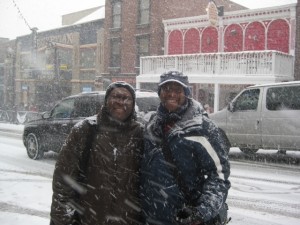
The Brothers Brown: Marvin (left) and John, caught in flurries at Sundance in Park City. (Credit: John Brown)
seemed like something special, and people who seemed like they were from Mars.
Two things I will take back with me is the memory of the special time I shared with my brother, and the fun of being around so many strangers who, like me, just love the experience of watching films. Good films, bad films, long and short ones. Funny, serious, crazy, romantic and disturbing.
But I’d have to say the most powerful experience of Sundance is that for me it served as a linking tool of my life, tying together the decades between two kids—Marv and Amp—stomping off to the movies like little Siskel and Eberts, and the two married men—Marvin and John—who returned to that era (if only for a few days) and found they’re still a lot like those two kids who loved watching movie magic together.
| Check out our time at Sundance 2011 by clicking here.
Sights and sounds of Sundance

The cast of Another Happy Day (from left): Ellen Barkin, Demi Moore, Kate Bosworth, Daniel Yelsky, Ezra Miller and Siobhan Fallon. (Credit: John Brown)
| Check out our time at Sundance 2011 by clicking here.
*Note: Since marvincbrown.com had not been created at the time of the 2011 Sundance Film Festival, I decided to go back and repost these reviews and festival items, which were catalogued elsewhere—mainly because I needed to get these reviews into my archives, but also because it was an enjoyable experience I’d like to share.
Sundance Film Festival 2011*
Park City, Utah
The Main Event
Among Day Three’s assortment of films and stars was a nice diversion to the heart of Park City and the Sundance Film Festival: Main Street. Nestled between the Wasatch Mountains and adorned with quaint and sleek storefronts, the main strip is alive with celebrities, tourists and industry hopefuls.
With mountains peeking over every roof and around every bend, Main Street seems at once an upscale getaway and an inviting hometown. Great shops and eats on every block. Friendly crowds, which is status quo for Park City, never took away from attractive smallness of the Main.
Lunch was had at The Eating Establishment—yes it was—a great restaurant near the top of the ascending Main Street. The breakfast portions are huge and the burgers have to be held with two hands. Interestingly, some store facades are manipulated to hype up the Sundance angle, so you might wonder why your favorite shop suddenly has a new name.
Main Street was great. If you’re going to take a break from screening films, yeah, this will do the trick!

Eccles Theater is one of several theaters around Park City that screen Sundance films. (Credit: John Brown)
My brother seems surprised to find a Playboy store on the main strip. It’s either new, or one of those Sundance Surprises.
Snow alert: Up until today it’s been clear skies. But today on Main Street, Sundance got its snow. And snow. And more snow. By the time lunch was done, the sidewalk and streets were covered.
OK, on to the shows.
| Movie reviews from Sundance screenings:
Beats, Rhymes & Life: The Travels of a Tribe Called Quest
| Lights come up. Saying goodbye to Park City.
*Note: Since marvincbrown.com had not been created at the time of the 2011 Sundance Film Festival, I decided to go back and repost these reviews and festival items, which were catalogued elsewhere—mainly because I needed to get these reviews into my archives, but also because it was an enjoyable experience I’d like to share.
Sundance Film Festival 2011*
Park City, Utah
Win Win (2011)
Rated R
Reviewed by John Brown
Win Win, directed by Tom McCarthy (The Station Agent, The Visitor) and starring Paul Giamatti (Sideways, American Splendor), was definitely the first movie I saw at Sundance that I think families will enjoy–aside from a little language. Giamatti plays Mike Flaherty, a small-town lawyer who, struggling to get by financially, turns to desperate measures by lying to the court about one of his clients in order to make extra money. While things seem to be going as planned, a kid

Marvin Brown and director Tom McCarthy at the screening of McCarthy’s film Win Win (Credit: John Brown)
related to his client shows up and just happens to be a great wrestler. As Mike tries to use the kid, Kyle (newcomer Alex Shaffer), to turn around the losing high school wrestling team Mike coaches, the lies continue and the laughs begin.
The storyline is lighthearted and funny, which makes you feel for Mike and his situation while laughing at him and his friends as incompetent coaches. Shaffer was actually found through a casting call and is actually a successful high school wrestler, which makes the storyline more believable and his acting just seems like he is being himself as a teenager.
The movie reminds me of the feeling I had watching Little Miss Sunshine (2006) as I laughed and felt sorrow throughout, but much more laughter and in the end walked out with a very happy feeling from a feel-good story. On the Marvin Brown scale: See it.
*Note: Since marvincbrown.com had not been created at the time of the 2011 Sundance Film Festival, I decided to go back and repost these reviews and festival items, which were catalogued elsewhere—mainly because I needed to get these reviews into my archives, but also because it was an enjoyable experience I’d like to share.
Sundance Film Festival 2011*
Park City, Utah
Beats, Rhymes & Life: The Travels of a Tribe Called Quest (2011)
Rated R
Beats, Rhymes & Life: The Travels of a Tribe Called Quest is a documentary of legendary 80s rap group A Tribe Called Quest, directed by actor Michael Rapaport. It’s all here: the humble beginnings, when the talented nobodies hook up; their deserved rise to stardom (heads bobbed as the film ran through the hits); the strain of too many know-it-alls, desires to do solo work, health issues, etc.; the inevitable breakup and reunion; and the where-are-they-now bit.
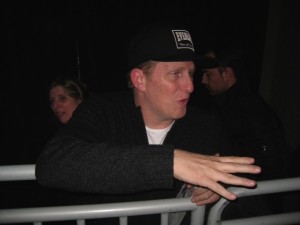
Actor/director Michael Rapaport chats up the crowd during a late-night screening of his documentary of A Tribe Called Quest. (Credit: John Brown)
What Rapaport, surely a fan of Tribe, gets right is the importance of the group and what that meant to other rappers of the day. He smartly zeros in on Tribesman Phif Dawg, the short, round, insecure yet talented co-lead rapper of the group, when another director (most directors) would be tempted to build the film around Q-Tip, the flat-out genius of the group. Phif’s easy-going nature pulls the audience in and humanizes the film, then hooks us when his health issues and clashes with Q-Tip emerge. That Phif was the only Tribe member to show up at the screening was icing on the cake.
Rapaport stumbles, I think, by not showing longer clips of the Tribe’s performances. The talking heads tell us how good they are, the film talks of Tribe’s influence and successes, but it would have been nice to hear why fans still ache for another album.
If you’re interested in the scenario: See it.
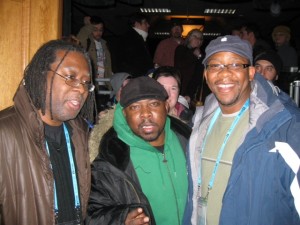
From left, Marvin Brown, rapper Phif Dawg and John Brown attend the screening of a documentary featuring Phif. (Credit: John Brown)
UPDATE: Remembering the late Phif Dawg.
*Note: Since marvincbrown.com had not been created at the time of the 2011 Sundance Film Festival, I decided to go back and repost these reviews and festival items, which were catalogued elsewhere—mainly because I needed to get these reviews into my archives, but also because it was an enjoyable experience I’d like to share.
| Marvin Brown’s Movie Review Archive
Sundance Film Festival 2011*
Park City, Utah
Red State (2011)
Rated R
Kevin Smith’s Red State was one of the most controversial films at Sundance 2011. Smith, ever the class clown, entered a packed Eccles Theater describing outside anti-gay protestors as “fans,” and went to town mocking the protestors, even though his film honors their right to protest. If that wasn’t enough, Smith opened bidding on distribution rights for Red State before a crowd of potential studio investors, then, in some kind of rebuke to Hollywood establishment, reversed himself and declared he would distribute the film himself. OK.
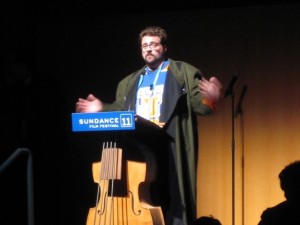
Director/podcast guru Kevin Smith yucks it up at Eccles Theater before the debut screening of his first horror film Red State. (Credit: John Brown)
The film, talky and juvenile on the front end, takes on religious fundamentalism with an odd mix of horror (done well) and action (done equally well), that ultimately doesn’t live up to its full potential.
What it gets right is fantastic. Five deaths in the film are powerfully depicted and each drew startled reactions from the crowd. It’s a hard thing to do in a horror film, to make that many deaths mean more than a body count. And a scene of blaring trumpets stopped the film in its tracks (in the good sense) and for a moment I was off the map of my cinematic experiences and didn’t know what to think or how to react. It was a moment that skirted greatness, but doesn’t achieve it.

*Note: Since marvincbrown.com had not been created at the time of the 2011 Sundance Film Festival, I decided to go back and repost these reviews and festival items, which were catalogued elsewhere—mainly because I needed to get these reviews into my archives, but also because it was an enjoyable experience I’d like to share.
Sundance Film Festival 2011*
Park City, Utah
Meek’s Cutoff (2010)
Rated PG
Meek’s Cutoff/John’s Shortcut: A quiet little film that won’t be seen by 98 percent of America is about three families on the 19th Century Oregon Trail that get lost while supposedly taking a shortcut through the bleak landscape.
Kelly Reichardt’s film is deliberately paced, synched with the rhythms of daily life on the Trail, and rich in period detail. Bruce Greenwood—unrecognizable as the dusty, hairy, irascible Stephen Meek—leads the families on a doom journey he’s supposedly taken before.
Michelle Williams (Blue Valentine, My Week with Marilyn) stands tall as the young matriarch of one of the families. She watches in the background and keeps her place as the men—her husband among them—hash out their dilemma. As things go from bad to worse, she subtly inserts herself into the negotiations (Should they abandon the obviously lost Meek and strike out on their own? What to do about the Indian they’ve captured along the way?), eventually going head-to-head with Meek himself—something the men seem afraid to do.
The punishing, sepia-toned/sun-scorched landscape—rolling endlessly, dry, sharp weeds and dull rock—eventually overtakes the senses and draws out dread.
After a screening of My Idiot Brother (renamed Our Idiot Brother once it made its way to theaters) was both delayed and ran long, my brother John Brown and I were left with 20 minutes to find the Prospect Theater for a screening of Meek’s. We had no time to wait for a bus and decided to hoof it over to the Prospect, even though we weren’t sure where we were going. After getting directions twice, we sprinted across snow, down alleyways and made the closed-door screening by the skin of our teeth. Things ended better for us than those wagon-trail families, I’ll tell you that.

*Note: Since marvincbrown.com had not been created at the time of the 2011 Sundance Film Festival, I decided to go back and repost these reviews and festival items, which were catalogued elsewhere—mainly because I needed to get these reviews into my archives, but also because it was an enjoyable experience I’d like to share.
| Marvin Brown’s Movie Review Archive
Sundance Film Festival 2011*
Park City, Utah
Hobo with a Shotgun (2011)
Rated R
The title says it all. Hobo with A Shotgun. If that puts a smile on your face and you like nonstop, cartoonish violence and whatever-the-moment-needs plotting, come on in, the water’s warm … and bloody.
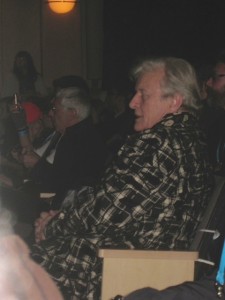
Rugter Hauer attends a late-night screening of Hobo with a Shotgun at the Library Theater in Park City. (Credit: John Brown)
Director Jason Eisener (V/H/S/2) aims his post-apocalyptic film for the distant horizon then puts the petal to the floor.
Rutger Hauer’s title vagrant mills about the worst town in America, watching men, women and children alike slain by a sadistic meanie and his equally abhorrent sons.
All’s good until things get personal for our bummy hero. He picks up a shotgun and … you know the rest. Only the Midnight Movie Madness crowd and/or gorehounds need apply.
*Note: Since marvincbrown.com had not been created at the time of the 2011 Sundance Film Festival, I decided to go back and repost these reviews and festival items, which were catalogued elsewhere—mainly because I needed to get these reviews into my archives, but also because it was an enjoyable experience I’d like to share.
| Marvin Brown’s Movie Review Archive
Sundance Film Festival 2011*
Park City, Utah
Martha Marcy May Marlene (2011)
Rated R
Past and present collide gently and shockingly in Sean Durkin’s evocative Martha Marcy May Marlene. Making its debut here in Park City, the effective drama charts the escape of Martha (an amazing Elizabeth Olsen, Oldboy) from her two-year life in a backwoods, Upstate New York cult. After reconnecting with her estranged sister (Sarah Paulson)—her only remaining family—Martha tries to make sense of her values, purpose and trauma.
As the film tracks backward, we sense the mounting dread of cult life, but tense present-day scenes underscore that unstable family relationships may have helped drive Martha to the cult. Lead and supporting roles are gripping from top to bottom. But let’s single out veteran character actor John Hawkes (Winter’s Bone, The Sessions), whose quiet menace as the cult’s leader chills the blood.
Subtle editing and past-present transitions are powerful. Durkin’s direction—sure-handed, never showy—packs a punch.
See it | Skip it
*Note: Since marvincbrown.com had not been created at the time of the 2011 Sundance Film Festival, I decided to go back and repost these reviews and festival items, which were catalogued elsewhere—mainly because I needed to get these reviews into my archives, but also because it was an enjoyable experience I’d like to share.

